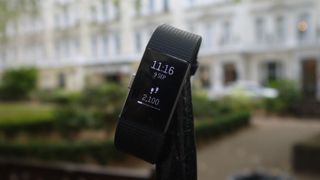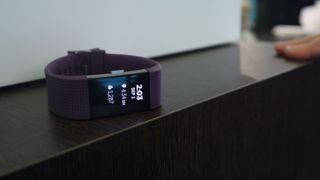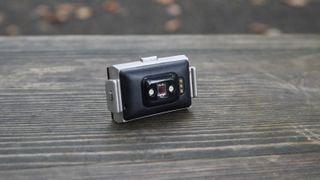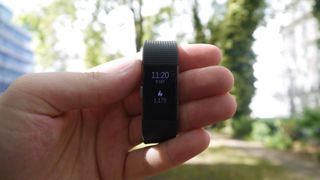Why you can trust TechRadar
Specs, performance and fitness
- No GPS on board, but will use your phone's
- Guided Breathing feature useful for relaxing
- Now lets you pause and resume workouts
- Always-on heart rate tracker
In terms of tracking tech, the Fitbit Charge 2 monitors your step count throughout the day, but it also features some of the innovations seen on the Fitbit Blaze and Alta.
As standard the Charge 2 will set you a goal of 10,000 steps a day, but you can adjust that total in the app depending on your aims.
A key improvement over the original Charge is that the Charge 2 offers multi-sport tracking – you can track outdoor running, treadmill running, walking and weight training, as well as bike, elliptical trainer and interval workouts.


Compatibility: iPhone and Android
Display: OLED
Battery life: Up to 5 days
IP rating: Splashproof
The Fitbit Charge 2 tracks your exercise automatically, so you don't have to start sessions manually – if you start running, for example, the Charge 2 detects this and begins monitoring. It also lets you start, then pause a workout without ending a session.
It means you don't always need to remember to press buttons when you're exercising – although if you're embarking on a specific workout we'd recommend setting up the tracker to ensure you're getting the exact readings you want.
For the sports-minded, this is a big reason to go for the Charge 2 over one of Fitbit's older devices.
Bear in mind that this isn't the best device on the market for running – there's no GPS tracking here, and if you want a dedicated device we'd recommend the Fitbit Surge, or a more expensive running watch.
The Fitbit Charge 2 will at least work with your phone's GPS to track the distance traveled – a feature both the original Charge and the Charge HR lack. It does mean you need to take your phone out for a run with you though.
A real highlight of the Charge 2 is the PurePulse heart rate tracking technology, which will constantly take a reading of your beat without you having to wear a chest strap.
Since it launched, Fitbit has patched in a new heart rate zone visualization feature, which allows you to see the heart rate zone (you guessed it) and adjust your efforts from there.

There's also a new Guided Breathing feature, which monitors your heart rate for 30 seconds and then sets you a breathing challenge to help improve your condition.
This is the first time Fitbit has offered this kind of feature, and we found that it would indeed calm down our heart rate when we wanted it to. It's interesting to see Fitbit focus on a feature that's not entirely exercise-focused, and it's a welcome addition.

If you wear the Fitbit Charge 2 in bed it'll monitor your sleeping patterns. Like other Fitbit products, this feature is a little more temperamental.
We found the Charge 2 would record a bad night's sleep when we felt that we'd actually slept quite well; and given that the tracker can also be quite uncomfortable to wear when you're in bed we certainly wouldn't recommend buying it solely for the sleep tracking tech.
There's also a silent alarm mode, which vibrates the tracker on your wrist to gently wake you without disturbing anyone else close by. It's a nice idea – if you don't mind keeping the tracker on when you're in bed – although it may not prove all that useful if you're a heavy sleeper.
Image Credit: TechRadar
Current page: Specs, performance and fitness
Prev Page Introduction, price and design Next Page Compatibility, app and battery lifeJames is the Editor-in-Chief at Android Police. Previously, he was Senior Phones Editor for TechRadar, and he has covered smartphones and the mobile space for the best part of a decade bringing you news on all the big announcements from top manufacturers making mobile phones and other portable gadgets. James is often testing out and reviewing the latest and greatest mobile phones, smartwatches, tablets, virtual reality headsets, fitness trackers and more. He once fell over.

